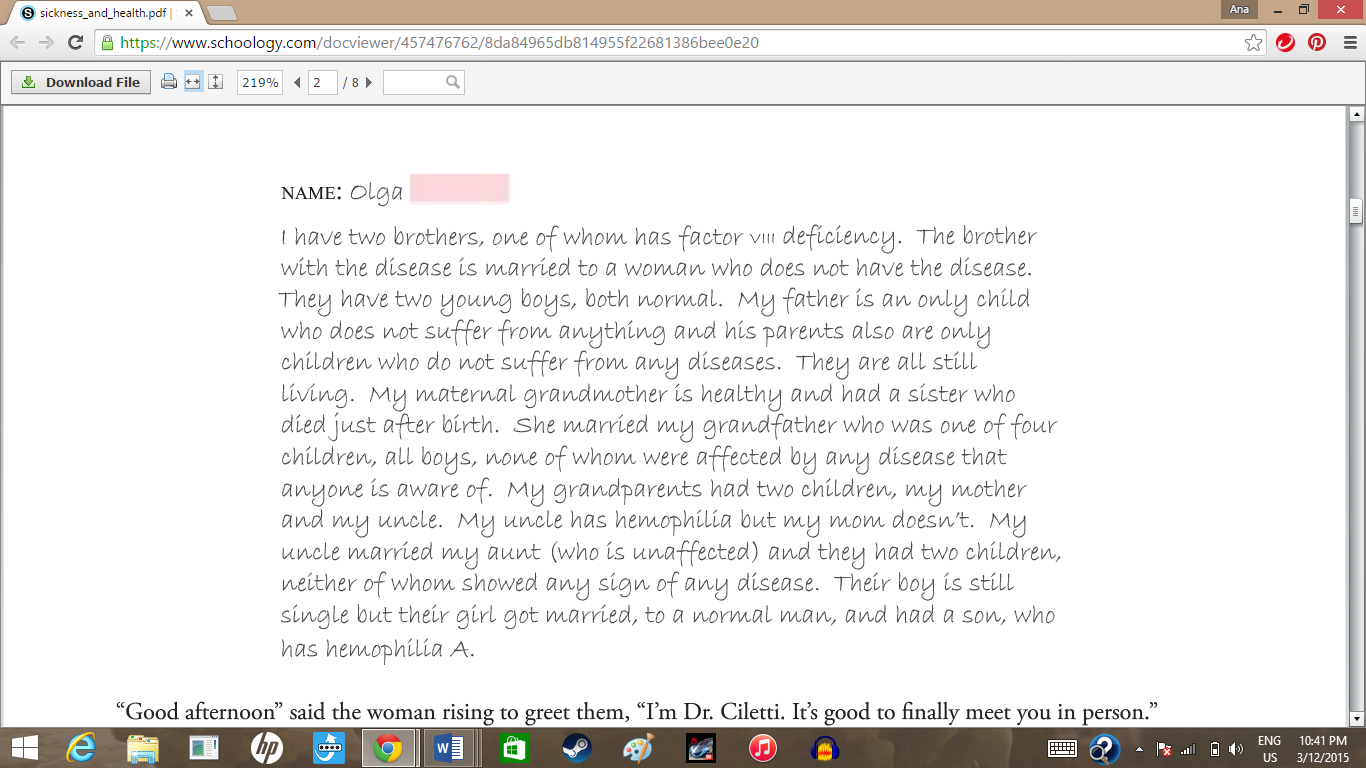For this post, we are going to create a family pedigree for a couple who wishes to have children. We will evaluate the pedigree to predict the risk of their offspring having Hemophilia or Myotonic Dystrophy. We are also going to evaluate this situation to further understand the reasoning behind the risk prediction.
Shown below are the letters that Greg and Olga sent in regarding their families.
To set a basic understanding for this pedigree, I am going to define a few symbols shown. Each circle on the pedigree represents a female family member, while each square represents a male family member. Shapes completely filled in with purple represents family members affected by Hemophilia, while shapes filled in completely with blue represent family members affected by Myotonic Dystrophy. Shapes that are not colored in represent family members who are unaffected by either disorder. Shapes that have a large X threw them represent deceased family members. The pedigree outlined in red represents Greg's side of the family while the pedigree outlined in green represents Olga's family.
Myotonic Dystrophy is classified as an"autosomal dominant disorder", meaning that a disease can be inherited through only one parent, if the gene is dominant. This means that the disorder is passed down directly, without skipping generations. It also means that if the disorder is not inherited by a child, it can no longer be passed down through that child. Because Myotonic Dystrophy is autosomal dominant disorder, and the gene is not present in either Greg or Olga, they are not carriers of the gene and cannot pass the disorder down to their offspring.
When viewing the pedigree, on might wonder about the possibility of Greg's aunt or uncle being homogeneous for the Myotonic Dystrophy gene. Being that only one parent carried the gene, only one abnormal gene was inherited, causing the aunt and uncle to be heterogeneous for the Myotonic Dystrophy gene. You might also question how it can be determined that Greg's cousin does not have Myotonic Dystrophy, being that symptoms sometimes don't appear until after the age of fifty. Being that neither of the cousin's parents were affected by this gene, it can be determined that it would be impossible for the cousin to have Myotonic Dystrophy.
Now, let's discuss the matter of Hemophilia inheritance. As discussed, Myotonic Dystrophy is classified as an "autosomal dominant disorder", but what about Hemophilia?
Another type of classification of gene inheritance is that of an "autosomal recessive disorder", meaning that two abnormal genes are required in order to be affected by the disorder. If a person only inherits one abnormal gene, they become carriers of the disorder, however, they are not affected. This is the type of disorder that has the ability to skip generations. Is Hemophilia an autosomal recessive disorder?
It is important that we discuss another concept, that of consanguinity. Consanguinity is simply where two individuals from the same biological background mate. Consanguinity increases the probability of an individual involved to become a carrier of an autosomal recessive disorder. Again, this recessive trait can skip generations until it has the opportunity to create offspring that is homogeneous with the autosomal recessive disorder gene.
When tracing the pattern of inheritance of the Hemophilia disorder, we begin to see a pattern. It becomes clear that only male individuals within the family inherited this disorder. Hemophilia is a sex-linked disorder, indicating that Hemophilia is not an autosomal recessive disorder.
Sex-linked disorders are often classified in X-linked recessive inheritance. This means that specific disorders, such as Hemophilia, are attached to the X chromosome. Due to the fact that males do not pass down the X chromosome directly to their male offspring, the X-linked recessive inheritance is passed down through the female offspring, then on to the male grandchildren. Males do not receive the X chromosome from their father because the father passes down the Y chromosome down to the son while the mother passes down the X chromosome. The fathers can, however, pass down their X chromosome to their female offspring. This causes men to more likely be affected by diseases passed down through X-linked recessive inheritance. In order for females to display a sex-linked trait such as Hemophilia, she must inherit a defective X chromosome from both parents.
Why don't we apply the concept of carrying an X-linked recessive gene to the pedigree of Greg and Olga? If we evaluate the family's history, we can see that Olga's mother, grandmother, and cousin were most definitely carriers of Hemophilia, while there is only a possibility of Olga being a carrier. If we evaluate Greg's family, we can see that Greg's mother, grandmother, and great-grandmother were definitely carriers while there is only the possibility of Greg's aunt and cousin being carriers. Greg is unaffected. Being that Olga has the possibility of being a carrier, there is a 50% chance that this trait would be passed down to her offspring. If the trait was passed down to a son, the son would be affected by the disorder. If the trait was passed down to a daughter, the daughter would only be a carrier. Again, there is only a 50% chance of Olga being a carrier, which means that there is the possibility that the trait will not be passed down to the offspring under any circumstance.



No comments:
Post a Comment